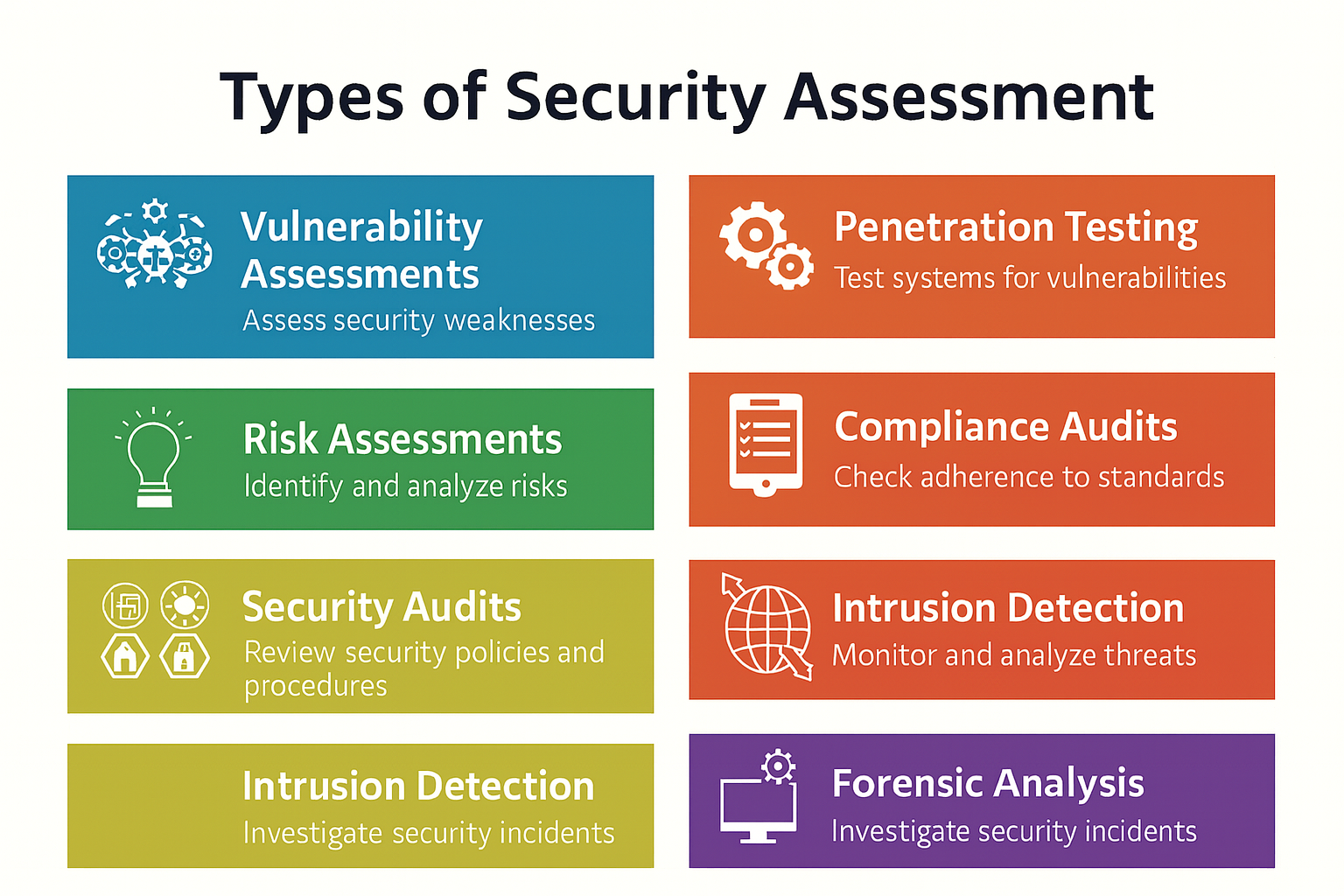Comprehensive Security Assessment Services: What You Need to Know to Protect Your Organization
Comprehensive Security Assessment Services: What You Need to Know

Effective security assessment services systematically evaluate an organization’s systems, networks, and applications to uncover hidden risks and strengthen defenses before incidents occur. In this guide, you will discover what comprehensive security assessments entail and why they are essential, explore the main assessment types and specialized evaluations, learn about post-assessment support, understand why Vertriax is the trusted partner for tailored solutions, review common questions demystified, and examine emerging trends shaping the future of security evaluations. Each section delivers clear, actionable insights to help you protect your organization from evolving threats.
What Is a Comprehensive Security Assessment and Why Is It Essential?
A comprehensive security assessment is a structured evaluation that probes vulnerabilities, analyzes threat vectors, and delivers prioritized remediation recommendations to reduce risk and enhance resilience. By combining technical testing and business-risk analysis, it ensures both digital and physical controls align with your security objectives, laying the groundwork for proactive defense. Link to our full overview of Comprehensive Security Assessment Services.
How Does a Security Assessment Identify Vulnerabilities and Risks?
A security assessment identifies vulnerabilities by scanning devices, networks, and applications for misconfigurations, outdated patches, insecure settings, and code flaws, then correlates findings with threat intelligence to quantify risk.
- Discovery – Maps assets and attack surfaces.
- Scanning & Testing – Uses automated tools and manual analysis.
- Risk Analysis – Prioritizes findings by likelihood and impact.
- Reporting – Provides actionable remediation steps.
This risk-focused process feeds directly into design and operations, ensuring controls evolve with emerging threats.
What Are the Key Benefits of Regular Security Assessments?
Regular security assessments drive continuous improvement and compliance through measurable outcomes:
- Risk Reduction: Identifying and remediating weaknesses minimizes breach likelihood.
- Regulatory Alignment: Ensures adherence to GDPR, HIPAA, PCI DSS, ISO 27001 and other standards.
- Cost Avoidance: Prevents expensive incident response and reputational harm.
- Security Posture Enhancement: Provides metrics to track progress over time.
Benefits of Regular Security Assessments
Regular security assessments are crucial for risk reduction, ensuring compliance with regulations like GDPR, HIPAA, and PCI DSS, and avoiding costly incident response. They also enhance an organization's security posture by providing metrics to track progress over time, which steers strategic investment and supports enterprise resilience.
National Institute of Standards and Technology (NIST), "Risk Management Framework for Information Systems and Organizations" (2018)
This research supports the importance of regular security assessments in aligning with regulatory standards and improving overall security posture.
How Do Security Assessments Improve Your Overall Security Posture?
Security assessments improve posture by highlighting control gaps, validating existing defenses, and guiding resource allocation for the highest risk areas. Actionable reports drive targeted system upgrades, staff training, and policy refinements, creating a cycle of continuous hardening that aligns technical safeguards with business priorities. As each assessment closes, your organization gains greater visibility and assurance that defenses remain robust against evolving attack techniques.
What Are the Main Types of Security Assessments Offered?

Comprehensive security assessment services encompass multiple specialized evaluations that, when combined, provide a holistic view of risk and remediation pathways. Below is a comparison of core assessment types.
| Assessment Type | Scope | Focus |
|---|---|---|
| Vulnerability Assessment | Automated and manual scans of assets | Identification of known weaknesses |
| Penetration Testing | Simulated attacks on networks/apps | Exploitation of vulnerabilities |
| Risk Assessment | Business-impact and likelihood review | Prioritization of threat scenarios |
| Compliance Assessment | Audit against regulatory frameworks | Verification of controls and documentation |
Types of Security Assessments
Comprehensive security assessment services include vulnerability assessments, penetration testing, risk assessments, and compliance assessments. Each type serves a distinct purpose, from identifying known weaknesses to simulating real-world cyberattacks and verifying adherence to legal and contractual obligations.
SANS Institute, "Penetration Testing and Ethical Hacking" (2022)
This source provides a framework for understanding the different types of security assessments and their respective focuses.
What Is a Vulnerability Assessment and How Does It Work?
A vulnerability assessment combines automated scanning tools with expert verification to detect misconfigurations, missing patches, and insecure code in systems, networks, and applications, then ranks each finding by severity. By quantifying exposure through rating scales (e.g., CVSS), this service pinpoints critical weaknesses that require immediate action, reducing the attack surface before adversaries exploit them.
How Does Penetration Testing Simulate Real-World Cyberattacks?
Penetration testing emulates threat actors by leveraging manual techniques and specialized tools to exploit vulnerabilities under controlled conditions, validating defenses against real-world tactics. Testers perform black-box, white-box, or grey-box engagements—ranging from external network breaches to internal privilege escalations—providing proof of concept attacks and actionable mitigation plans that reinforce detection and response capabilities.
What Does a Risk Assessment Involve and Why Is It Critical?
A risk assessment evaluates organizational assets, threat sources, and business impacts to calculate quantitative and qualitative risk scores, then recommends mitigation strategies aligned with risk appetite. By mapping vulnerabilities to business processes, it prioritizes controls that deliver the greatest reduction in potential financial, operational, and reputational damage, ensuring resources focus on truly critical exposures.
How Do Compliance Assessments Ensure Regulatory Adherence?
Compliance assessments audit policies, procedures, and technical controls against standards such as GDPR, HIPAA, PCI DSS, and ISO 27001 to verify legal and contractual obligations are met. Through gap analysis, evidence collection, and control testing, this service delivers detailed remediation roadmaps that close compliance gaps, mitigate fines, and demonstrate due diligence to auditors and stakeholders.
How Are Specialized Security Assessments Tailored to Different Environments?
Specialized assessments dive deep into unique risk landscapes—such as software development, cloud platforms, network segments, and data repositories—providing targeted evaluations that address distinct threat vectors and compliance requirements.
| Environment | Challenge | Focus |
|---|---|---|
| Application Security | Code vulnerabilities and logic flaws | SAST, DAST, API security testing |
| Cloud Security | Misconfigurations and shared risk model | IaaS, PaaS, SaaS controls and reviews |
| Network Security | Lateral movement and segmentation gaps | Firewall rules, intrusion detection |
| Data Security | Unauthorized access and leakage | Data classification, encryption, DLP |
What Is Application Security Assessment and Its Role in Software Protection?
An application security assessment evaluates source code, binaries, and runtime environments using static (SAST) and dynamic (DAST) analysis to uncover injection flaws, broken authentication, and insecure API endpoints. By integrating security testing into the software development lifecycle, this assessment prevents vulnerabilities from reaching production and embeds defense-in-depth in digital services.
How Does Cloud Security Assessment Address Cloud-Specific Risks?
A cloud security assessment examines configuration settings, identity and access management policies, network design, and service integrations across IaaS, PaaS, and SaaS offerings to identify misconfigurations, excessive privileges, and shared-responsibility gaps. It recommends architecture improvements that enforce least privilege, segmentation, and continuous compliance monitoring within the dynamic cloud environment.
What Are the Key Elements of Network Security Assessment?
A network security assessment reviews firewall configurations, network segmentation, virtual private networks, intrusion detection/prevention systems, and endpoint security controls. By mapping traffic flows and testing internal and perimeter defenses, it verifies that network architectures minimize exposure to unauthorized access and lateral movement, ensuring robust boundary enforcement.
How Does Data Security Assessment Protect Sensitive Information?
A data security assessment classifies data by sensitivity, evaluates encryption implementations at rest and in transit, and tests data loss prevention controls. It uncovers gaps in access policies and storage practices, then prescribes technical and procedural safeguards that prevent unauthorized disclosure, meet privacy mandates, and preserve data integrity.
What Happens After a Security Assessment? Understanding Post-Assessment Services

After identifying and prioritizing risks, ongoing services ensure continuous protection, governance, and compliance through design, operations, and monitoring.
- Security Operations (SecOps) – Continuous incident detection and response.
- Security Design and Management – Implementation of remediation controls.
- Security Monitoring Services – Real-time threat analysis and alerts.
These services translate assessment findings into live defenses that adapt as threats evolve, maintaining a robust security posture.
How Do Security Operations (SecOps) Support Continuous Monitoring?
Security operations integrate threat intelligence, log analysis, and vulnerability management to detect anomalies and orchestrate incident response workflows. By centralizing alert handling and correlating events, this service reduces mean time to detect and resolve security incidents, ensuring assessment insights drive continuous vigilance. Learn more about our Security Operations.
What Is Security Design and Management’s Role in Risk Mitigation?
Security design and management translate assessment recommendations into practical architecture and policies—covering surveillance, access controls, network segmentation, and system hardening—to close identified gaps. This strategic oversight ensures that remediation aligns with business objectives and security best practices. Visit our Security Design and Management page for details.
How Can Security Monitoring Services Detect Emerging Threats?
Advanced security monitoring services employ behavioral analytics, anomaly detection, and automated alerting to identify potential breaches in real time. By correlating telemetry from endpoints, networks, and cloud environments, this service uncovers previously unseen attack patterns and triggers rapid containment measures. Explore our Security Monitoring Services for continuous protection.
Why Choose Vertriax for Your Comprehensive Security Assessment Services?
Vertriax combines deep technical expertise with tailored methodologies and industry-leading tools to deliver end-to-end security assessment services. We extend our specialized approach into areas such as Travel Security, Event Security, and Background Check Oversight to ensure every dimension of your risk landscape is covered.
What Expertise Does Vertriax Bring to Security Assessments?
Vertriax’s assessment teams hold certifications in CISSP, OSCP, CEH, and ISO 27001 Lead Auditor standards, backed by decades of experience across finance, healthcare, and government sectors. Our proprietary testing frameworks accelerate vulnerability discovery and maximize remediation ROI while maintaining strict confidentiality and rigor.
How Does Vertriax Tailor Assessments for High-Stakes Industries Like Pharmaceuticals?
Through our Vertriax Pharma Solutions, we address the unique integrity, quality control, and regulatory demands of drug development and distribution. Customized assessment protocols enforce product integrity standards, secure supply chains against counterfeiting, and support pharmacovigilance through robust data protection measures.
What Are the Advantages of Vertriax’s Integrated Security Approach?
Vertriax integrates physical and digital security services—from executive close protection to systems hardening—to deliver unified risk management. Our approach synchronizes security design, operations, and monitoring under a single governance framework, enhancing situational awareness and reducing the operational complexity of managing disparate providers.
What Are Common Questions About Security Assessment Services?
Organizations frequently seek clarity on choosing the right assessments, frequency, tools, and timelines to optimize both security and budget.
What Is the Difference Between Vulnerability Assessment and Penetration Testing?
A vulnerability assessment scans and catalogs known weaknesses, whereas penetration testing exploits select vulnerabilities under controlled conditions. The former provides breadth of coverage; the latter delivers proof of concept and validates the resilience of defenses against real-world attack methodologies.
How Often Should Organizations Conduct Security Assessments?
Frequency depends on business risk and regulatory demands, but best practices call for at least quarterly vulnerability scans, annual penetration tests, and continuous monitoring. High-risk environments or compliance frameworks such as NIST CSF and GDPR often require more frequent or event-driven assessments.
What Tools and Methodologies Are Used in Security Assessments?
Assessment engagements leverage industry-standard tools like Nessus, Qualys, Burp Suite, and Nmap alongside custom scripts and manual analysis. Methodologies follow OWASP Testing Guide, NIST SP 800-115, and ISO 27002 frameworks to ensure comprehensive coverage and consistent reporting across engagements.
How Long Does a Typical Security Assessment Take?
Assessment timelines vary by scope: vulnerability scans can be completed in days, penetration tests in two to four weeks, and full risk/compliance audits in six to eight weeks. Clear scoping and stakeholder alignment accelerate delivery without compromising depth.
How Are Emerging Trends Shaping the Future of Security Assessment Services?
Advanced technologies, regulatory shifts, and new delivery models are redefining security assessments to be more predictive, continuous, and integrated.
- AI & Machine Learning: Automating vulnerability detection and threat hunting.
- Regulatory Evolution: Driving more frequent and granular assessments.
- Cloud Adoption: Expanding assessment scope to multi-cloud and hybrid architectures.
- MSS & Security-as-a-Service: Delivering continuous, on-demand assessments.
Staying ahead of these trends ensures your security program remains dynamic and compliant. Contact us to discuss how these innovations apply to your organization.
How Is AI Enhancing Vulnerability Assessments and Threat Detection?
AI-driven analytics accelerate the identification of zero-day vulnerabilities by correlating massive datasets, automating false-positive reduction, and predicting attacker behavior. This proactive capability boosts detection accuracy and enables rapid remediation workflows.
What Impact Do Regulatory Changes Have on Security Assessment Frequency?
New regulations, such as updates to GDPR and NIST CSF, often mandate increased assessment cadence and comprehensive evidence collection. Organizations must adapt schedules to include continuous monitoring and event-triggered reassessments to maintain compliance.
Why Is Cloud Security Assessment Growing in Importance?
As enterprises migrate critical workloads to cloud platforms, misconfiguration risk and shared-responsibility gaps magnify. Cloud security assessments ensure controls scale with dynamic infrastructure and enforce least-privilege access models, preserving data protection in elastic environments.
How Are Managed Security Services (MSS) and Security-as-a-Service (SaaS) Changing Assessments?
MSS and Security-as-a-Service models deliver continuous, subscription-based assessments that integrate seamlessly with threat intelligence feeds and orchestration platforms. This shift from periodic audits to always-on evaluation enhances agility and ensures assessment insights drive real-time defense adjustments.
Make a decisive move to protect your organization by partnering with a security leader committed to continuous innovation and tailored expertise.
Contact Vertriax today to request a consultation and take the next step toward a resilient security posture.
Frequently Asked Questions
What should organizations do to prepare for a security assessment?
Preparing for a security assessment involves several key steps. Organizations should first conduct an internal review of their existing security policies and controls. This includes gathering documentation on current security measures, identifying key stakeholders, and ensuring that all relevant personnel are informed about the assessment process. Additionally, organizations should ensure that all systems and applications are up-to-date and that any known vulnerabilities are documented. This preparation helps streamline the assessment process and allows for a more accurate evaluation of the organization's security posture.
How can organizations ensure the effectiveness of their security assessments?
To ensure the effectiveness of security assessments, organizations should engage qualified professionals with relevant certifications and experience. It's also crucial to define clear objectives and scope for the assessment, aligning them with business goals and compliance requirements. Regularly updating assessment methodologies and tools to reflect the latest threats and vulnerabilities is essential. Furthermore, organizations should prioritize follow-up actions based on assessment findings, ensuring that remediation efforts are implemented and monitored for effectiveness over time.
What role does employee training play in security assessments?
Employee training is a critical component of security assessments as it helps to mitigate human-related risks. Training programs should focus on raising awareness about security best practices, recognizing phishing attempts, and understanding the importance of data protection. By equipping employees with the knowledge to identify and respond to potential threats, organizations can enhance their overall security posture. Regular training sessions, combined with assessments, can help reinforce security protocols and ensure that employees remain vigilant against evolving threats.
How do organizations choose the right type of security assessment?
Choosing the right type of security assessment depends on several factors, including the organization's specific needs, industry regulations, and existing security posture. Organizations should evaluate their risk profile and identify areas of concern, such as compliance requirements or known vulnerabilities. Consulting with security experts can provide insights into the most appropriate assessment types, whether it be vulnerability assessments, penetration testing, or compliance audits. Tailoring the assessment to address unique organizational challenges ensures a more effective evaluation and remediation strategy.
What are the common challenges faced during security assessments?
Common challenges during security assessments include scope creep, lack of stakeholder engagement, and insufficient documentation of existing security measures. Organizations may also struggle with resource constraints, making it difficult to allocate time and personnel for thorough assessments. Additionally, resistance from employees who may be apprehensive about the assessment process can hinder progress. To overcome these challenges, clear communication, defined objectives, and a collaborative approach involving all stakeholders are essential for a successful assessment.
How can organizations measure the success of their security assessments?
Organizations can measure the success of their security assessments through various metrics, such as the number of vulnerabilities identified and remediated, compliance with regulatory standards, and improvements in incident response times. Tracking the effectiveness of implemented recommendations over time is also crucial. Additionally, conducting follow-up assessments can help gauge progress and ensure that security measures remain effective against evolving threats. Regular reporting and analysis of these metrics provide valuable insights into the organization's security posture and areas for further improvement.
Conclusion
Comprehensive security assessment services are essential for identifying vulnerabilities and enhancing your organization's defenses against evolving threats. By regularly conducting these assessments, you not only reduce risks and ensure compliance but also strengthen your overall security posture. Take the proactive step of partnering with a trusted expert like Vertriax to tailor solutions that meet your unique needs.
Contact us today to explore how we can help safeguard your organization.



